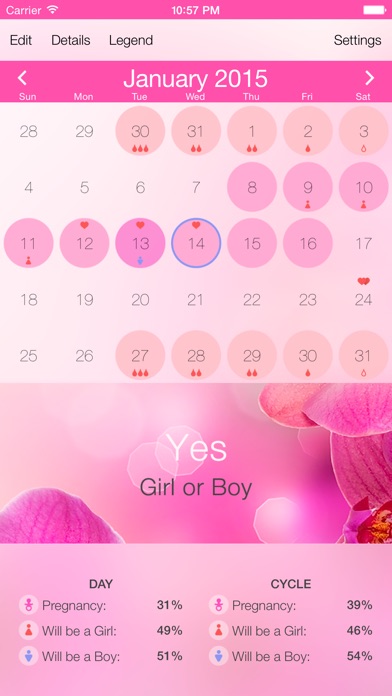

You may have noticed on the calendar that in addition to menstruation being outlined in red, there are also dates outlined in blue. Have more period questions? We have answers. The period tracker can also help you calculate your ovulation date Your date of ovulation is when the egg is released from your ovary. This will give you the average number of days in your cycle, and once you know this number, you'll be able to track your period easily. Do this for a few cycles, then add up the total number of days and divide them by the number of cycles. This is the number of days in one menstrual cycle. Ovulation calendar allows you to track menstrual cycle and receive notifications of menstrual period, ovulation and contraceptive pills taking. It will also let you know which days are most fertile for you. Then we need to know the average length of your menstrual cycle so we can calculate the. Prediction function, it can effectively manage the safe period, menstrual period and dangerous period. Once you have entered these details, the ovulation calendar will generate an estimate date. The APP provide warm care and rigorous calculation for women menstrual period, leave the precious record and make healthy life every day. Start counting on the first day of your period and stop counting on the day before your next period. To start using an ovulation calendar, enter the first day of your last menstrual period, your average cycle length, and your basal body temperature. To calculate your period, you'll need to count the days in between your last few periods. In a 28-day cycle, ovulation typically occurs on day 14. This is the time when you’re ovulating and at the highest risk for pregnancy. See your doctor if you find yourself bleeding through six or seven regular tampons a day, or if you’re on your period for more than seven days. Your periods happen around every 23 to 35 days and youre most likely to ovulate roughly two weeks before your period, although it varies woman to woman. Bleeding usually amounts to somewhere between 10-80 grams, or 1 to 6 tablespoons of fluid (not that we’re measuring, but it’s good to know for keeping track of tampon changes).An average cycle is 28 days, but can range from 21 to 35 days (to work yours out use a period cycle tracker).There are about 6 days during each menstrual cycle when you can get pregnant. The typical menstrual cycle is 28 days long, but each woman is different. You can also record your cervical mucus, BMI, weight, temperature, symptoms or moods. It can track your chance of pregnancy every day. Healthy periods generally last between four and seven days, with the heaviest days being the first and second Ovulation calculator Knowing the days you are most likely to be fertile can increase your chance of getting pregnant. Period Tracker is useful, whether you have irregular periods or regular periods.But why do we bleed in the first place? Since your egg wasn’t fertilised, your womb lining sheds and leaves your body. This is the start of your cycle and when bleeding begins. Resist the urge to have an extra cup of coffee.While these symptoms can be painful and uncomfortable, the good news is there are ways to help manage them: And just so you know: diet, caffeine and stress can increase the intensity of PMS symptoms.

It’s common to experience PMS in the three days leading up to your period. In other words, that urge to sit on the couch in joggers with a tub of ice cream and cry over ‘The Notebook’. If they are irregular, other methods may be more accurate for estimating when ovulation will occur. It can be helpful to maintain a menstrual calendar to determine how regular your periods are. Some common symptoms of PMS are headaches, bloating, irritability and crying more than usual. The first day of the menstrual cycle is the day that bleeding starts, and it ends the day that bleeding starts again. All cycles are unique, but between pre-period, period and ovulation, there are a few things we all have in common:

What’s important is that you find out what’s normal for you a period tracker will help you to do just that. Eating a healthy, nutrient-dense diet can help, too.First of all, stop thinking about normal. You'll want to kick unhealthy habits like smoking and start incorporating regular exercise into your routine if you aren't exercising already. Staying up-to-date with vaccinations and regular check-ups and testing can lower the risk of complications during pregnancy.
#MENSTRUAL PERIOD TRACKER AND OVULATION CALENDAR HOW TO#
Find out how to use an ovulation predictor kit, chart your basal body temperature, and pay attention to changes in cervical mucus. See other ways to pinpoint your fertile days and increase your chances of becoming pregnant.


 0 kommentar(er)
0 kommentar(er)
